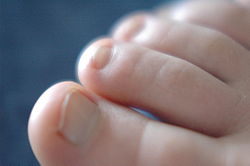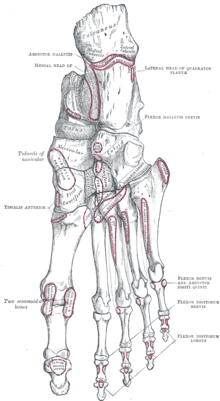- Toe
-
Toes 
Toes on the foot. The innermost toe (bottom-left in image), which is normally called the big toe, is the hallux. Latin digiti pedis Toes are the digits of the foot of a tetrapod. Animal species such as cats that walk on their toes are described as being digitigrade. Humans, and other animals that walk on the soles of their feet, are described as being plantigrade; unguligrade animals are those that walk on hooves at the tips of their toes. The toes are, from medial to lateral:
- Hallux ("big toe" or "great toe"), the innermost (most proximal) toe and the closest to the toes of the other foot
- Second toe or "long toe" (although commonly shorter than the big toe and often the third or fourth toes)
- Third toe, occasionally described as the "ring toe"
- Fourth toe, sometimes described as the "ring toe"
- Fifth toe ("little toe", "pinky toe", or "baby toe"), the outermost (most distal) toe
Contents
Toe anatomy and physiology
The human foot consists of numerous bones and soft tissues which support the weight of the upright human. Specifically, the toes assist the human while walking,[1] providing balance, weight-bearing, and thrust during the gait. Toe bones articulate around the metatarsal bones which make up the central portion of the human foot. The joints between bones of the toe are known as interphalangeal joints. Movements are generally instigated by way of tendons actuated by muscles in the lower leg.
The hallux (large toe) is primarily flexed by the flexor hallucis longus muscle, located in the deep posterior of the lower leg, via the flexor hallucis longus tendon. Additional flexion control is provided by the flexor hallucis brevis. It is extended by the abductor hallucis muscle and the adductor hallucis muscle. The remaining toes are primarily controlled by the flexor digitorum brevis muscle and the extensor digitorum brevis muscle. Finally, the fifth toe (the smallest toe) has a separate set of control muscles and tendon attachments, the flexor and abductor digiti minimi. Numerous other foot muscles contribute to fine motor control of the foot. The connective tendons between the minor toes accounts for the inability to actuate individual toes.
Humans typically have five toes. Exceptions include polydactyly (more than five toes), and syndactyly or amputation (fewer than five toes). The four smallest toes consist of three phalanx bones, while the largest consists of two phalanx bones and two sesamoid bones. Many of the flexor tendons are shared, making it impossible to move individual toes independently; however, some prehensility, or grasping capability, does exist for most humans.
Forefoot shape, including toe shape, exhibits significant variation among people; these differences can be measured and have been statistically correlated with ethnicity.[2] Such deviations may affect comfort and fit for various shoe types. Research conducted by Freedman for the U.S. Army[3] indicated that larger feet may still have smaller arches, toe length, and toe-breadth. Specifically measurable toe and forefoot metrics for humans include[2]:
- height
- breadth and girth
- ball length
- digital pattern
- heel to toe length
- footprint layout
Each of these metrics has been correlated to particular ethnic groups, but absolute deviations in dimensions are relatively small; such deviations may or may not be practically significant from the ergonomic or comfort standpoint.
Injuries
A sprain or strain to the small interphalangeal joints of the toe is commonly called a stubbed toe.[4] A sprain or strain where the toe joins to the foot is called turf toe. A bunion is a structural deformity of the bones and the joint between the foot and big toe, and may be painful.[5] Long-term use of improperly sized shoes can cause misalignment of toes, as well as other orthopedic problems.
Toe Pain
Patients often refer to all forms of toe abnormalities as a hammer toe. There are three main forms of toe abnormalities: claw toes, hammer toes and trigger toe. A hammer toe can be best described as an abnormal contraction or “buckling” of a toe. This is done by a partial or complete dislocation of one of the joints, which form the toes. Since the toes are deformed further, they will then press against the shoe and can cause corns.
Symptoms of Toe Pain
- A hammer toe may be painful, especially when irritated by a shoe.
- All four toes conditions can cause cramps in the toes, feet and legs due to the abnormal function of the tendons in the foot.
- If a mallet toe has occurred, you probably suffer from a corn at the end of the toe.
- A hammer toe may cause a corn on top of the toe (see picture below).* Infections and ulcers may also occur.
- Infections and ulcers may also occur.
- In severe cases, cause a mallet toe, toe, claw toes or hammer toes may press on the foot that can lead to hard skin and corns on the soles of the feet.
Causes of Toe Pain
Pain, occurs because of certain reasons. listed the causes of pain in the toe.
- Inappropriate shoes.
- Flat feet can result in hammertoes, this is due to poor mechanics of the foot.
- High arched feet can also result in wrinkles toes.
- A major cause is hereditary, all the toes because the conditions could be acquired, hereditary factors.
- Bunions are one of the main causes of hammer toes.
- claw toes are usually the result of a shoe that is too short. For many people the second toe is actually longer than the big toe, and if shoes sized to fit the big toe is the second (and perhaps even the third toe) must bend to fit into the shoe. Shoes that are pointed make matters even worse. Combine pointed shoes with high heels, the foot under similar pressure as if it was constantly pushed downhill into a wall.
- Rheumatoid arthritis can also result in bales, which can lead to hammer toe
See also
- Ainhum
- Phalanges of the foot
- Finger, for the hand digits
- Hallux
- Morton's toe
- Nail (anatomy)
- Polydactyly and Syndactyly
- Runner's toe
- Toe cleavage
- Toe tag
- Webbed toes
- Toecuffs
References
- ^ Janey Hughes, Peter Clark, & Leslie Klenerman. The Importance of the Toes in Walking. The Journal of Bone and Joint Surgery, Vol. 72-B, No. 2. March, 1990. [1]
- ^ a b Ethnic differences in forefoot shape and the determination of shoe comfort. Hawes, Sovak, Miyashita, Kang, Yosihuku, and Tanaka. Ergonomics, Vol. 37, No. 1, Page 187. 1994. Available at [2]
- ^ Freedman, A., Huntington, E.C., Davis, G.C., Magee, R.B., Milstead, V.M. and Kirkpatrick, C.M.. 1946. Foot Dimensions of Soldiers (Third Partial Report), Armored Medical Research Laboratory, Fort Knox, Kentucky.
- ^ Your Health - Toe Sprain
- ^ American College of Foot and Ankle Surgeons. "Bunions". http://www.footphysicians.com/footankleinfo/bunions.htm. Retrieved 2008-03-05.
Human regional anatomy (TA A01.1) Head 
Neck Trunk Limbs General anatomy: systems and organs, regional anatomy, planes and lines, superficial axial anatomy, superficial anatomy of limbs
Wikimedia Foundation. 2010.

